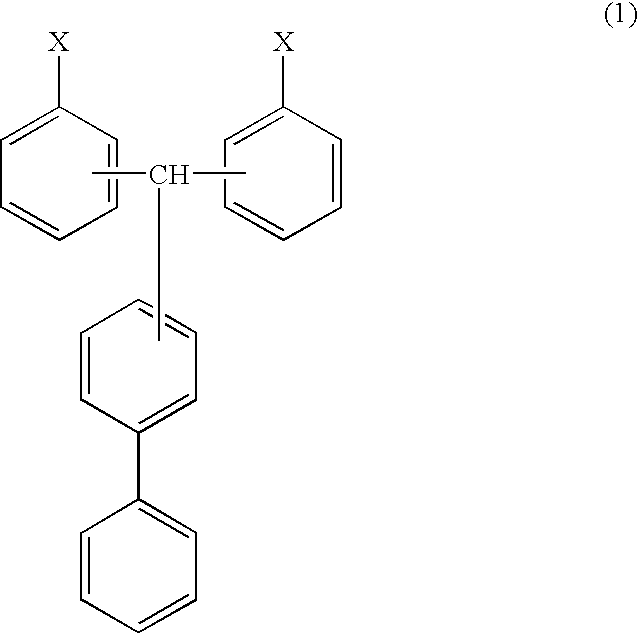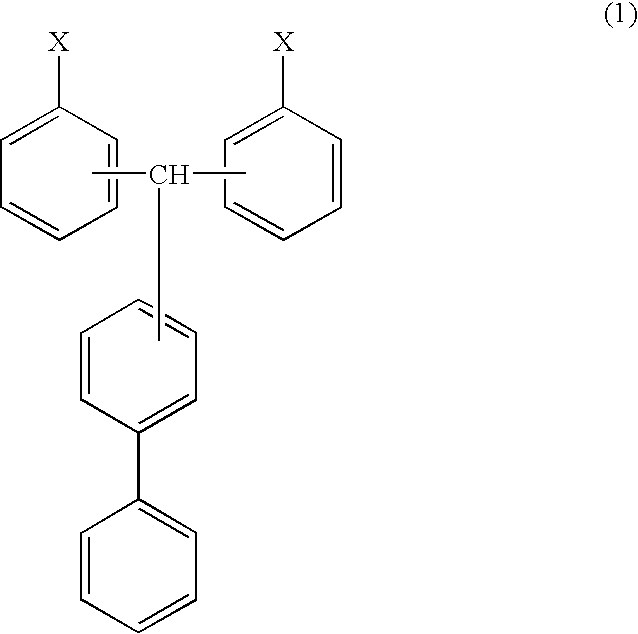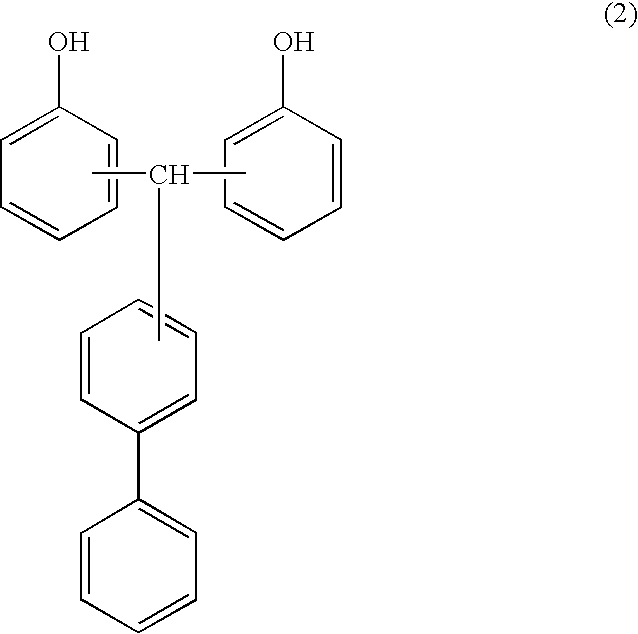Cyanate ester polymer
a polymer and ester technology, applied in the field of cyanate ester polymer, can solve the problems of increasing the requirement for the properties of functional polymer materials is becoming severe and severer, and the risk of generating corrosive bromine or hydrogen bromide is not always satisfied, so as to achieve excellent flame retardance, low dielectric constant, and low loss tangent
- Summary
- Abstract
- Description
- Claims
- Application Information
AI Technical Summary
Benefits of technology
Problems solved by technology
Method used
Image
Examples
examples
[0062]The present invention is described further specifically with reference to the following Examples, to which, however, the present invention should not be limited.
example a1
Synthesis of a cyanate ester of 4-biphenylaldehyde-bisphenol compound of (formula (3): abbreviated as BABP-CN)
[Chemical Formula 3]
[0063]
[0064]0.23 mol of 4-biphenylaldehyde-bisphenol compound and 0.51 mol of triethylamine were dissolved in 300 mL of methyl isobutyl ketone (Solution 1). At −10° C., the Solution 1 was dropwise added to a mixed solution of 0.60 mol cyan chloride / methylene chloride solution (200 g) and chloroform (1000 g), taking 1.5 hours. This was stirred for 30 minutes, then a mixed solution of 0.09 mol triethylamine and chloroform (25 g) was dropwise added, and further stirred for 30 minutes to complete the reaction. The obtained liquid was washed with 0.1 mol / L hydrochloric acid (1000 mL) and then with water (1000 mL), and this washing was repeated four times. After dried with sodium sulfate, this was evaporated at 75° C. to obtain a red brown viscous substance. Thereafter, this was dried at 90° C. under reduced pressure to obtain a red brown solid BABP-CN. This wa...
example b1
Production of a Polymer (a Cured Product)
[0066]BABP-CN obtained in Example A1 was weighed in an egg-plant type flask in a ratio as in Table 1, melted under heat at 150° C., then degassed via a vacuum pump, and thereafter zinc octylate was added and mixed with stirring for 1 minute. This was cast into a mold formed of a glass plate (120 mm×120 mm×5 mmt), a polyimide film (“Kapton200H” by Toray DuPont), a fluoro rubber-made O ring (“S-100” by Morisei), and cured by heating in an oven at 170° C. for 1 hour and at 230° C. for 9 hours. After cooled, the polyimide film was removed by grinding, thereby obtaining a polymer of the cyanate ester compound.
[0067]The characteristics of the obtained cured product were evaluated according to the following methods.
Glass Transition Temperature (Tg):
[0068]Measured through dynamic viscoelasticity analysis (DMA).
[0069]The sample was analyzed at an oscillation frequency of 10 GHz.
Dielectric Constant, Dielectric Loss Tangent:
[0070]Measured according to a...
PUM
| Property | Measurement | Unit |
|---|---|---|
| Percent by mole | aaaaa | aaaaa |
| Heat | aaaaa | aaaaa |
Abstract
Description
Claims
Application Information
 Login to view more
Login to view more - R&D Engineer
- R&D Manager
- IP Professional
- Industry Leading Data Capabilities
- Powerful AI technology
- Patent DNA Extraction
Browse by: Latest US Patents, China's latest patents, Technical Efficacy Thesaurus, Application Domain, Technology Topic.
© 2024 PatSnap. All rights reserved.Legal|Privacy policy|Modern Slavery Act Transparency Statement|Sitemap



